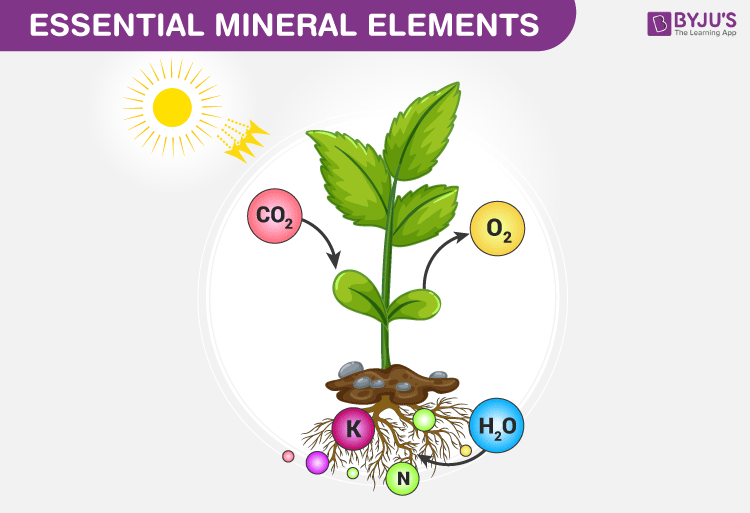Table of Contents
- Introduction
- What are Mineral Elements?
- Essential Mineral Elements in Plants
- Absorption of Mineral Elements in Plants
- Mineral Elements Functions in Plants
Introduction
As we all know plants receive water, minerals and other nutrients from the soil, which are carried to the other parts of the plant by tissue called the xylem. There are loads of minerals present in the soil that are absorbed by the root hairs and transferred to the other parts of the plant. This is how we all receive nutrients when we consume different parts of the plant.

What are Mineral Elements?
A large number of inorganic elements are essential for all life processes and hence should be taken into our diets in adequate amounts. A deficiency in these minerals leads to an abnormality in the metabolic functioning of the body.
As of now, around 105 minerals have been discovered and about 60 to 65 minerals are absorbed by plants from the soil. Different species of plants take up different minerals. A few essential minerals required by plants for their growth and development are calcium, nitrogen, potassium, phosphorus, magnesium, sulfur, etc.
Hydroponics is a technique in which plants are grown in mineral nutrient-rich solutions without soil. It is important to understand whether all the minerals absorbed by the plants are actually essential or not. There are a few techniques used to detect the essence of minerals in plants.
Here are some criteria to determine whether the minerals are essential for the plant. They are:
- Certain minerals like phosphorus and magnesium are essential for the reproduction, growth, and development of the plant.
- The minerals absorbed by the roots are mineral ions dissolved in the soil and water. They support plants to complete their life cycle and are to produce seeds.
- The deficiencies of nitrogen, iron, copper, and sulfur result in stunted growth, insufficient chlorophyll in leaves, cell senescence etc.
- Potassium elements increase the quality of fruits and vegetables
- Potassium, sodium, magnesium and other elements are involved directly in the metabolism of the plant.
Also Read: Uptake of Mineral Elements
Essential Mineral Elements in Plants
Based on their quantitative requirements, minerals are further divided into two broad categories:
Macrominerals
Phosphorous, carbon, sodium, nitrogen, potassium, silicon, magnesium, hydrogen, calcium, oxygen, selenium and sulphur are known as macrominerals and are generally required in large amounts by the plant tissues.
Microminerals
Iron, boron, nickel, manganese, copper, zinc, cobalt, chlorine, and molybdenum are known as microminerals or trace elements and are required by plants in small amounts.
Absorption of Mineral Elements in Plants
The mineral elements in plants are absorbed by the following two mechanisms:
Passive Mineral Absorption
This type of absorption does not require any energy and occurs along the concentration gradient by the process of simple diffusion.
Active Mineral Absorption
It is an active process and requires energy for the transfer of mineral elements against the concentration gradient.
Also Read: Apoplast
Mineral Elements Functions in Plants
Following are the important functions of mineral elements in plants:
In the Formation of Plant Body
Various mineral elements are found in the protoplasm and cell wall of the plants. For instance, nitrogen and sulphur are found in proteins, phosphorus is found in nucleic acids, magnesium in chlorophyll and iron in cytochromes.
Osmotic Potential of Cells
The mineral elements present in the cell sap determine the osmotic potential of plant cells which helps in maintaining the turgidity of the cells and facilitates water absorption by the plants.
Acidity and Buffer Action
The mineral elements absorbed by the plants influence the pH of the cell sap.
Influence on Permeability of Cytoplasmic Membrane
Various cations and anions in the mineral elements influence the permeability of the cytoplasmic membrane.
Catalytic Effects
Mineral elements such as copper, iron, zinc, and magnesium are responsible for the catalytic effects in plants.
Toxic Effects
If the mineral elements are present in very high concentrations, they might prove toxic to the protoplasm of plants. For eg., copper, arsenic and mercury.
Balancing Effects
Calcium, potassium, and magnesium neutralize the toxic effects of other minerals by maintaining the ionic balance.
Phloem Transport
Boron and potassium are responsible for the translocation of organic substances in the phloem.
Also Read: Symplast
To know more about essential mineral elements in plants, and their functions, keep visiting BYJU’S website or download BYJU’S app for further reference.

Comments